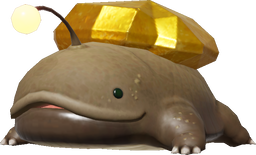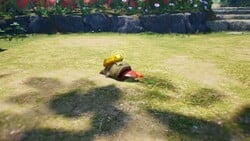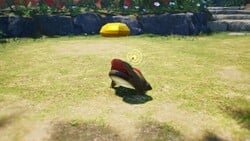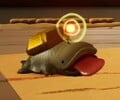Gildemandwee: Difference between revisions
CortexCPU242 (talk | contribs) (Added info) Tag: Mobile edit |
(Pikmin Garden render for infobox image.) |
||
| Line 2: | Line 2: | ||
{{infobox enemy | {{infobox enemy | ||
|pikmin4 = y | |pikmin4 = y | ||
|image = Gildemandwee | |image = Pikmin Garden Gildemandwee render.png | ||
|icon = Gildemandwee P4 icon.png | |icon = Gildemandwee P4 icon.png | ||
|size = 256px | |size = 256px | ||
Revision as of 21:17, June 27, 2024
| |||
|---|---|---|---|

| |||
| Appears in | Pikmin 4 | ||
| Scientific name | Salamandra falsaurum (juvenile) | ||
| Family | Amphibiland | ||
| Areas | Hero's Hideaway | ||
| Caves | Doppelgänger's Den, Dream Home | ||
| Dandori Challenge stages | None | ||
| Dandori Battle stages | None | ||
| Attacks | Eat Pikmin, confuse Treasure Gauge | ||
The Gildemandwee (ザコサンショウ?, lit.: "Small-Fry Salamander") is an enemy in Pikmin 4. It is a brown salamander-like creature with a glowing antenna like an Anglerfish, and a gold stone stuck to its back. It is the juvenile form of the Gildemander and can sometimes be found in nectar eggs.
Stats
| Weight | Max. carriers |
Seeds | Value | Health |
|---|---|---|---|---|
| 5 | 10 | 6 | 500 |
The HP for the chunk on the creature's back is the same as the actual healthbar, being 500.
Behavior
When alone, Gildemandwees waddle around slowly. When noticing the player or Pikmin, Gildemandwees start waddling quickly towards the intended target. To attack, the Gildemandwees use their tongues to lick up Pikmin to eat. When the Gildemandwee loses sight of the target it will stop in its tracks, look side to side and then resume slowly waddling.
If a player throws Pikmin onto the gold stone on their back they will eventually shake them off if the Pikmin don't take the stone off. When the gold stone falls after being attacked, Gildemandwees get slightly dazed before rushing over to the stone. Using its tongue, it will flip the stone back onto its back. If the gold stone is destroyed before it can put it back onto its back, it will still continue to try and attack its target, now with an exposed weak spot. If a Gildemandwee is defeated, it will stick out its tongue and flip on its back.
If a Gildemandwee is active in the area or sublevel, the Treasure Gauge will act as if there is treasure remaining, even if the area or sublevel is 100% cleared. This even goes as far as the game warning the player that they have not collected all treasures on the current sublevel, should a Gildemandwee still be alive after collecting all treasures when attempting to leave the current sublevel.
Appearance
Gildemandwees have brown bodies, white belly, black beady eyes and stubby limbs. They somewhat resemble real-world salamanders. On its forehead is a dangling lantern, similar to an anglerfish, with a pulsing yellow light. On its back is a gold-colored stone that the Gildemandwee uses to protect the weak spot underneath the stone. If exposed, the weak spot is a red lump that shatters upon defeat. If the gold stone is destroyed whilst the Gildemandwee is still alive, the lantern turns off.
Gildemandwees are actually the baby forms of Gildemanders, although unlike their adult counterparts, they only have one gold chunk and can't effectively use their antennas to control Pikmin.
Locations
Strategy
|
The following article or section contains guides. |
The Gildemandwee has only one weak spot on his back, which is the only spot that is capable of taking damage. This spot is protected by a false gold nugget that has to be picked off before attacking. This can be accomplished by throwing Pikmin at it, in which case Purple Pikmin are the best option due to their high impact damage and ability to latch on, but it is preferable to use Oatchi's rush attack, since the trajectory of the attack allows Pikmin to latch onto the weak spot once the nugget is removed. Care must be taken to manage your squad, if any Pikmin are attacking the nugget when the Gildemandwee retrieves it, they will perish.
Notes
Dalmo's notes
Olimar's notes
“Immediately after hatching, this species presents itself in a gilled, tadpole-like form and grows its legs after about a week.
This juvenile Gildemander specimen is estimated to be about a month old due to the presence of an ore-like growth on its back and the fact that it has already emerged onto land.
Louie's notes
Other information
- Pikmin 4 Piklopedia number: #62
Naming
- See more: Amphibiland family#Naming.
- Common name: Gildemandwee. "Gilde" may refer to the word "gilded", meaning golden, "mand" may refer to the middle part of the word "salamander", and "wee" refers to the word little, itself a reference to the Gildemandwee's juvenile form.
- Japanese nickname: ザコサンショウ?, lit.: "Small-Fry Salamander". It combines "雑魚?" (small fry) and "山椒魚?" (salamander).
- Japanese name: ニセガネオカアンコウ 幼体?, lit.: "Counterfeit Money Hill Anglerfish (juvenile)". "Counterfeit money" refers to the fake gold on its back.
- Scientific name: Salamandra falsaurum (juvenile). Salamandra refers to the real life genus of salamander. Falsaurum may be a combination of falsum, Latin for fraud and aurum, Latin for gold.
- Internal names:
NISEZAKO. "Nise" comes from "ニセガネ", which means counterfeit money. "Zako", or "ザコ", which means small fry, refers to how it is the juvenile form of Gildemander. - Prerelease: None.
Names in other languages
| Language | Name | Meaning | Notes |
|---|---|---|---|
| ザコサンショウ? Zako Sanshō |
Small-Fry Salamander | ||
| Kleine guldamander | Small gildemander | ||
| Aurimandrille | Little goldmander | "Aurimandre" (Gildemander) with the diminutive suffix "-ille" | |
| Schatzamanderlein | Gildemanderling | "Schatzamander" (Gildemander) with the diminutive suffix "-lein" | |
| Oromandrina | "Oromandra" (Gildemander) with the diminutive suffix "-ina" | ||
| 꼬마도롱뇽 Kkoma-Dorongnyong |
Little Salamander | ||
| Ouromandrinha | Little goldmander | "Ouromandra" (Gildemander) with the diminutive suffix "-inha" | |
| Aurimandrucha | "Aurimandra" (Gildemander) with the pejorative suffix "-ucha" |
Gallery
|
This article or section is in need of more images. Particularly: |
A Gildemandwee in the Piklopedia.
A Gildemandwee eating pikpik carrots.
A Gildemandwee popping out of a breakable pot in the Piklopedia.
A Gildemandwee as seen in Doppelgänger's Den.
A Gildemandwee in Hero's Hideaway.










